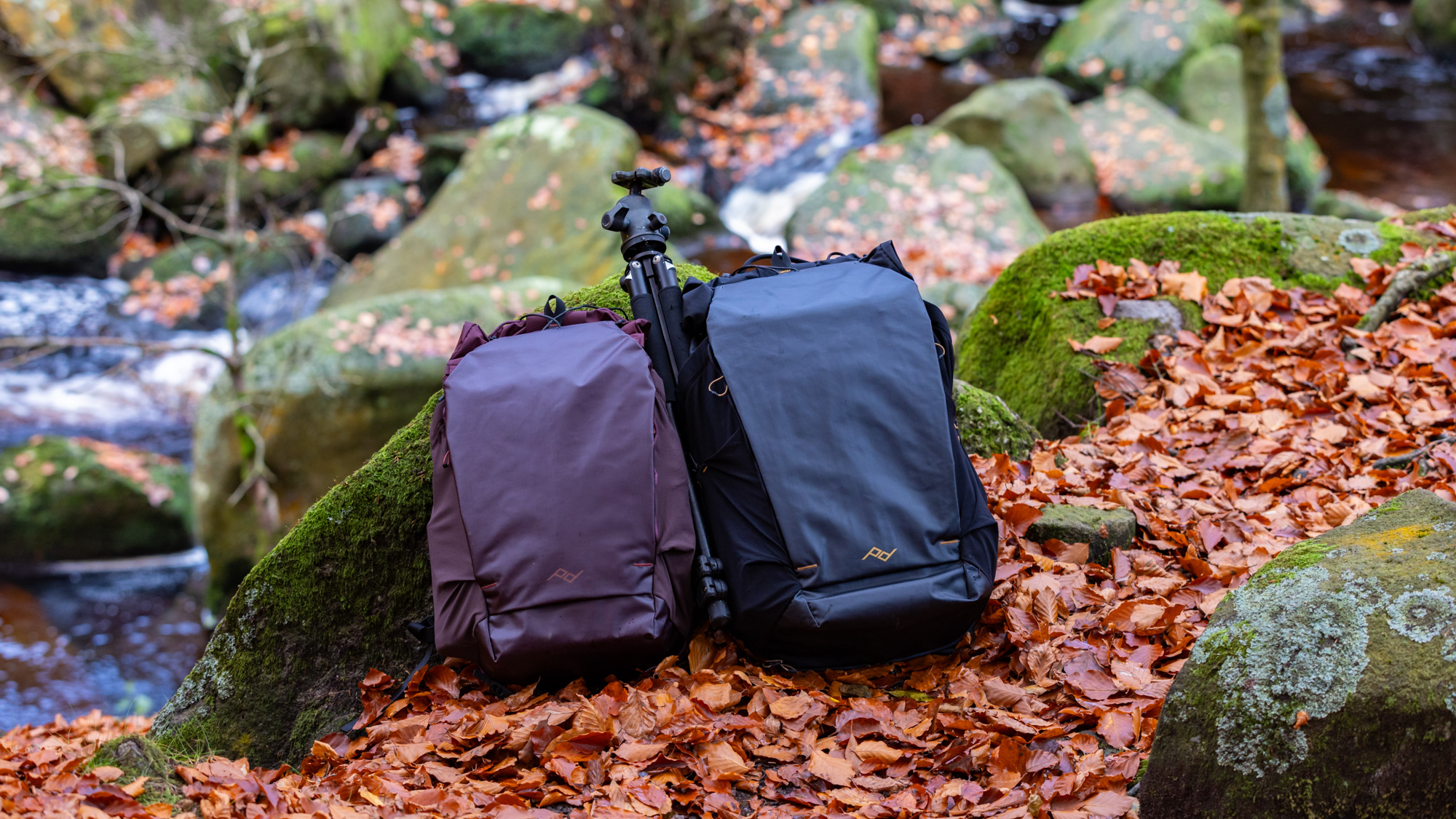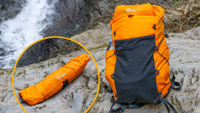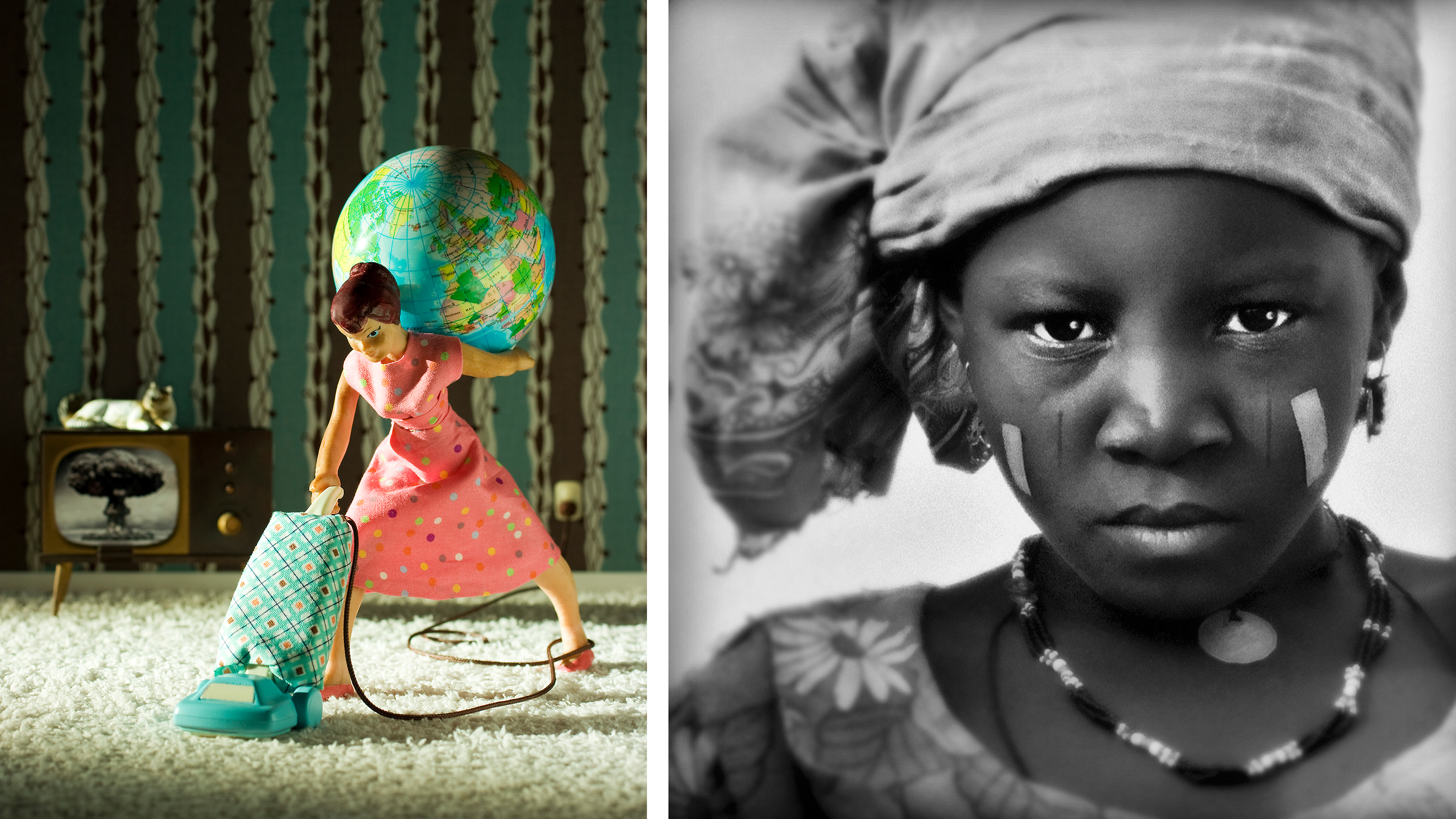Digital Camera World Verdict
These Outdoor Backpacks live up to their name and are well-suited to hiking, trekking and camping out in the wild. They feel more geared towards camping and hiking, with the photography features taking a bit of a backseat. This is partly due to the shallow depth of the Camera Cube inserts which work optimally with small and low profile kit such as mirrorless bodies and slim profile lenses. I also found it best to use smaller screw-in filters as my square ND filter holder case just didn’t fit inside the cubes in any practical fashion, though this could be stashed in the internal space outside of the cube. There’s also no small pockets for accessories like cables, memory cards, batteries or cleaning kit, so organization is awkward unless you have your own accessories pouch. In conclusion, the Outdoor Backpacks are well made and manufactured from very high quality and responsible materials – no crisitiscisms here. But the bags feel more geared towards those looking to go on epic and extensive outdoor trekking trips with just the core camera essentials, and if that’s what you’re looking for then either of these bags will work wonders for you. The good news is you can also remove the Camera Cube insert entirely and solely use the backpacks for just hiking, so they are quite versatile with one bag doing the job of many, and makes it better value for money.
Pros
- +
Premium materials
- +
Comfort
- +
Features
- +
Customization
- +
Water bladder and laptop storage
Cons
- -
Expensive
- -
Locked into its modular design
- -
Shallow depth of camera cubes hampers gear organization
Why you can trust Digital Camera World
Peak Design is a San Francisco-based photography accessory design company and is completely crowdfunded. Its most recent Kickstarter is a love letter for the outdoors and aimed at adventurers, hikers, and campers, aptly named the Peak Design Outdoor range and consists of 25L and 45L Outdoor Backpacks, 2L and 7L Outdoor Slings as well as modular Ultralight Packing Cubes and Camera Cubes to customize your bags and tailor them to you.
For this review I got hold of both the 25L and 45L Outdoor Backpacks, along with various sizes of its modular Camera Cube system, though there’s quite a lot to delve into, so you’ll find a separate in-depth review of the Camera Cubes here.
Peak Design claims its Outdoor backpacks are the company’s "most technically advanced bags ever" and consist of a large internally framed 45L for gear-heavy adventures and a smaller 25L for traveling fast and light. Peak Design proudly claims the Outdoor Backpacks "do things other outdoor bags can’t" and also boasts that its fine level of fit adjustment controls promises maximum comfort with "no bulky padding or gimmicky suspension". Peak Design is so confident in its products that it gives the Outdoor Backpacks a lifetime guarantee, too.
At the time of review, the Kickstarter had just finished, and early backers will have enjoyed a discount of up to 25% on some lines. But with the early bird phase sadly now ended the bags are quite expensive starting at $250 for the 25L Backpack or $400 bundled with Camera Cube SMedium, Small, X-Small, and XX-Small Ultralight Packing Cubes, and a Rain Fly weather shield. For the larger 45L Outdoor Backpack, it's $330, or $520 for a bundle including Camera Cube Large, Small, X-Small, and XX-Small Ultralight Packing Cubes and a Rain Fly weather shield. Shipping is slated to start in January 2025 so early adopters should get theirs around then.
Expensive they may be, but are they worth the investment? I took both of the 25L and 45L backpacks on a landscape trip up to the UK's picturesque Peak District to put both models through their paces.
Specifications
Price: $250 (25L) / $330 (45L)
External dimensions 25L (WxHxD): 48.5x28x15cm (roll-top down)
Internal dimensions 25L (WxHxD): 48x27.5x14.5cm (roll-top down)
External dimensions 25L (WxHxD): 66x28x15cm (roll-top extended)
Internal dimensions 25L (WxHxD): 65.5x27.5x14.5cm (roll-top extended)
External dimensions 45L (WxHxD): 56cm x 31cm x 17cm (roll-top down)
Internal dimensions 45L (WxHxD): 55.5cm x 30.5cm x 16.5cm (roll-top down)
External dimensions 25L (WxHxD): 78x31x17cm (roll-top extended)
Internal dimensions 25L (WxHxD): 77.5x30.5x16.5cm (roll-top extended)
Size options in range: 25L or 45L
Bag type: Backpack
Camera access: Rear
Laptop compartment: 16" or water bladder
Tripod fastener: Yes
Chest / Waist straps: Yes, waist straps only on 45L
Rain-proof cover: Yes
Weight: 1.15Kg or 1.55Kg
Build & Handling
As the name suggests, the 25L and 45L Outdoor Backpacks are both made for big adventures, hikes, and trails in the great outdoors, though there are some key differences between the two.
Let’s start with what the backpacks share in common. Both are available in a choice of three colorways: Black, Burgandy, and White, they’re also made from a 100% recycled weather-proof Terra Shell with 210D ripstop nylon which is PU coated and abrasion resistant.
As a bag designed for the Outdoors, Peak Design has shown it wants to respect the outdoors too. Both backpacks are bluesign approved which means it has been manufactured to strict safety and environmental requirements. It’s also free from PFAS forever chemicals, Fairtrade certified, and has been made with 100% Carbon neutral processes – impressive!
Both have lightning-fast access to the top via its Ultra Cinch for one-handed opening and quick pull closure and expansion for more gear. This reveals the magnetic roll top which can be expanded to add extra space or compact it down depending on your load. This front storage area is also where you can stash a hydration system or a small rain jacket.
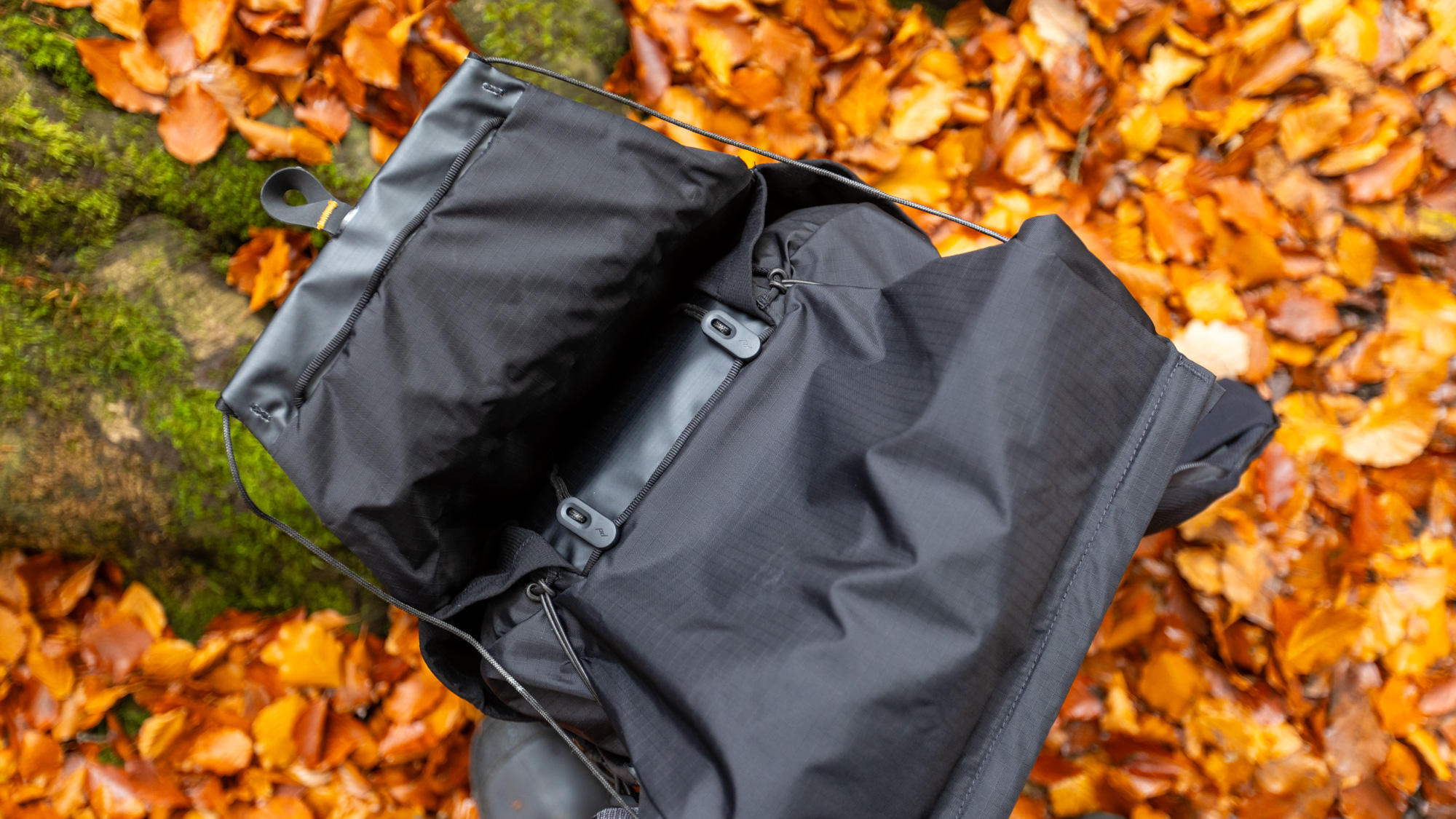
Both bags also feature Ultra Zips stitched with an ultra-high molecular weight polyethylene thread which Peak Design claims is weather-proof, abrasion resistant, and cut out for "decades of heavy use".
The shoulder straps on both were inspired by running vests, with dual sternum straps to distribute the load over a bigger surface area and stretchy netted pockets to stash items like a smartphone or sunglasses. They also have built-in capture points to mount a Peak Design Capture Clip to hang your camera off the shoulder strap or hip belt so you have access to your camera without diving into the bag.
Both feature Peak Design’s trademarked Cordhook, an external carry system for cinching items like roll mats and tents to your backpack, too.
The Outdoor Backpacks have a large rear hatch so you can quickly access everything. The bags work on a modular system and you can use a mixture of Peak Design’s Packing Cubes or Camera Cubes, available in a range of different sizes and all made to work perfectly and be interchangeable within the 25L and 45L Outdoor Backpacks. On the inside, both bags have a sleeve to stash a 16” laptop or tablet, or alternatively, a hydration bladder, though we recommend stashing the hydration system on the front of the bag instead so it’s not so close to your camera kit if it should leak.
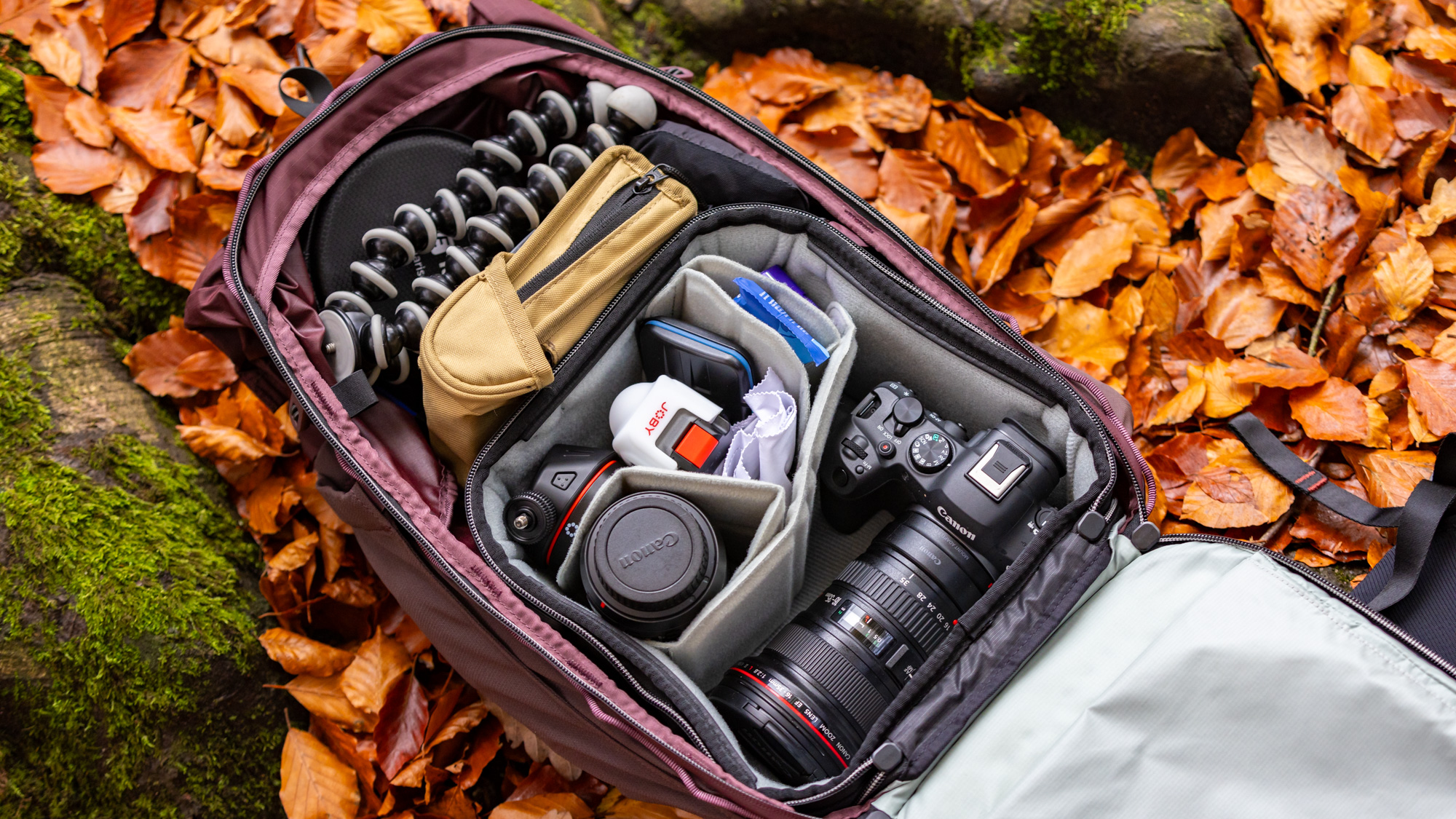
Both the 25L and 45L feature a comprehensive amount of customization to get the bags set optimal for your figure and both are made to cater for torso lengths around 17-20” and waist sizes of 24-52”.
We’ve covered what the two Outdoor Backpacks share in common, but what’s different? Well, the larger 45L can be folded down as small as 34.5L, while the 25L can be folded down to a very portable 20L, it’s also expectedly lighter at 1.15Kg compared to its 45L bigger brother which tips the scales at 1.55Kg.
The larger size of the 45L version gives it twice the amount of storage with three Peak Design ‘Cube Units’, compared to the 1.4 Cube Units in the 25L bag. This means the Large Camera Cube can be fitted to the 45L, though you don't have to use any Camera Cubes if you're not planning on doing any photography on your journey – you can remove the padded cube insert and stow a tent or sleeping bag!
The largest Camera Cube the 25L version can take is the 'SMedium' – so-called because it's somewhere between Peak Design's Small and Medium cube designs. With the SMedium Camera Cube fitted you can also fit a Small Packing Cube for clothes or toiletries.
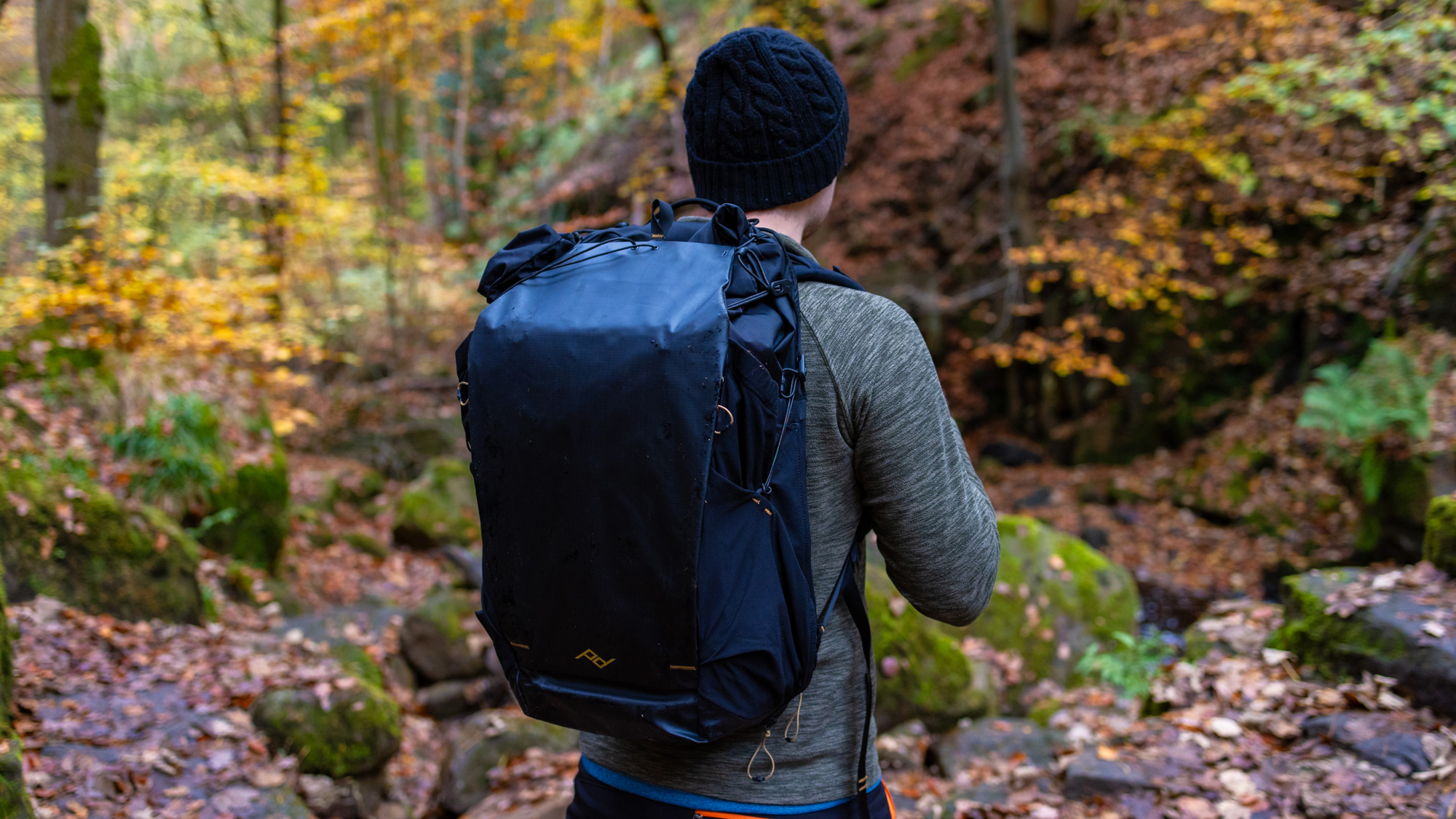
The 45L version comes with a waist strap or 'Hip Belt' as Peak Design calls it, and while the 25L model can be used with said waist strap you'll need to purchase it at an additional cost if you wish to use it.
The Hip Belt strap is removable on both models but the 45L version has a trick up its sleeve as the waist straps can be pivoted and folded upwards to tuck them behind the rear padding when not in use.
The hip belt also features a mesh pocket and another slip pocket on the other side for stashing items like snacks, and there’s a mounting point for a Peak Design Capture Clip if you’d like to hang your camera from your waist instead.
I delve into more detail on the Peak Design Camera Cubes here, where you’ll find my full review, but a quick overview they’re a modular camera box system for protecting your kit both in and out of the Outdoor Backpacks. They’re modular, interchangeable, and available in five different sizes: Extra Small, Small, SMedium, Medium, and Large, and can be used in tandem with the Peak Design Packing Cubes (available in Extra Extra Small, Extra Small, and Small sizes) which are better for clothes, gear, and food.
The Packing Cubes also come in either a weatherproof Versa Shell™ or breathable stretch mesh, the latter is better for items like clothes that you want to dry out.
The Camera Cubes also features tuck-away lids so you can remove the padding of the top lid and fold them out of the way and have instant access to your camera kit when you open the Outdoor Backpacks up via their large rear hatch door. They also feature Flexfold Dividers and an insulated weather-proof construction.
Lastly, the larger 45L is internally framed for more rigidity, comes with a hip belt, and has two Flex Pockets™ per side, whereas the 25L has just one per side – these are handy for stashing water bottles or tripods, and the 45L also has a four setting ladder system for strap attachment, whereas the 25L gets just one.
Phew! Now that we've covered all of the various features each Outdoor Backpack has to offer, let's see how they performed in some real-world trekking and hiking scenarios in the great outdoors!
Performance
Both the 25L and 45L Outdoor Backpacks delivered great comfort out on my hike with plenty of perforated foam padding and also large channels grooved into the foam which made it very breathable.
The bags have an internal Polyurethane (PU) coating and the external front face and base of the bag have a hardy Thermoplastic Polyurethane (TPU) coating to make it more resistant to the elements and hard-wearing too its other main ripstop nylon material are both resistant to a shower.
This rugged front face of the backpack was a standout feature for me as it's really hard-wearing so you know you can place your bag down on the ground and not worry about water seeping through to your camera kit, it's also really easy to wipe clean and is part of the Ultra Cinch™ system with this rugged 'Kangaroo flap' extending forward to allow you to stash items like a water bladder or small jacket inside of it if you don't have space in the internal compartment.
There is also the option to store a water bladder or 16" laptop in the hatch door of the internal compartment, though I personally didn't feel comfortable having a large amount of water next to my camera kit, after all accidents can happen.
The side pockets however are a mesh design and whilst great for stowing hiking poles, a large bottle of water, or a tripod, they're not waterproof so my gloves and spare socks got a bit damp from resting the backpack on the ground. Admittedly this was down to user error and I now know for future to keep items like these in the internal roll-top section of the bag to keep them dry.
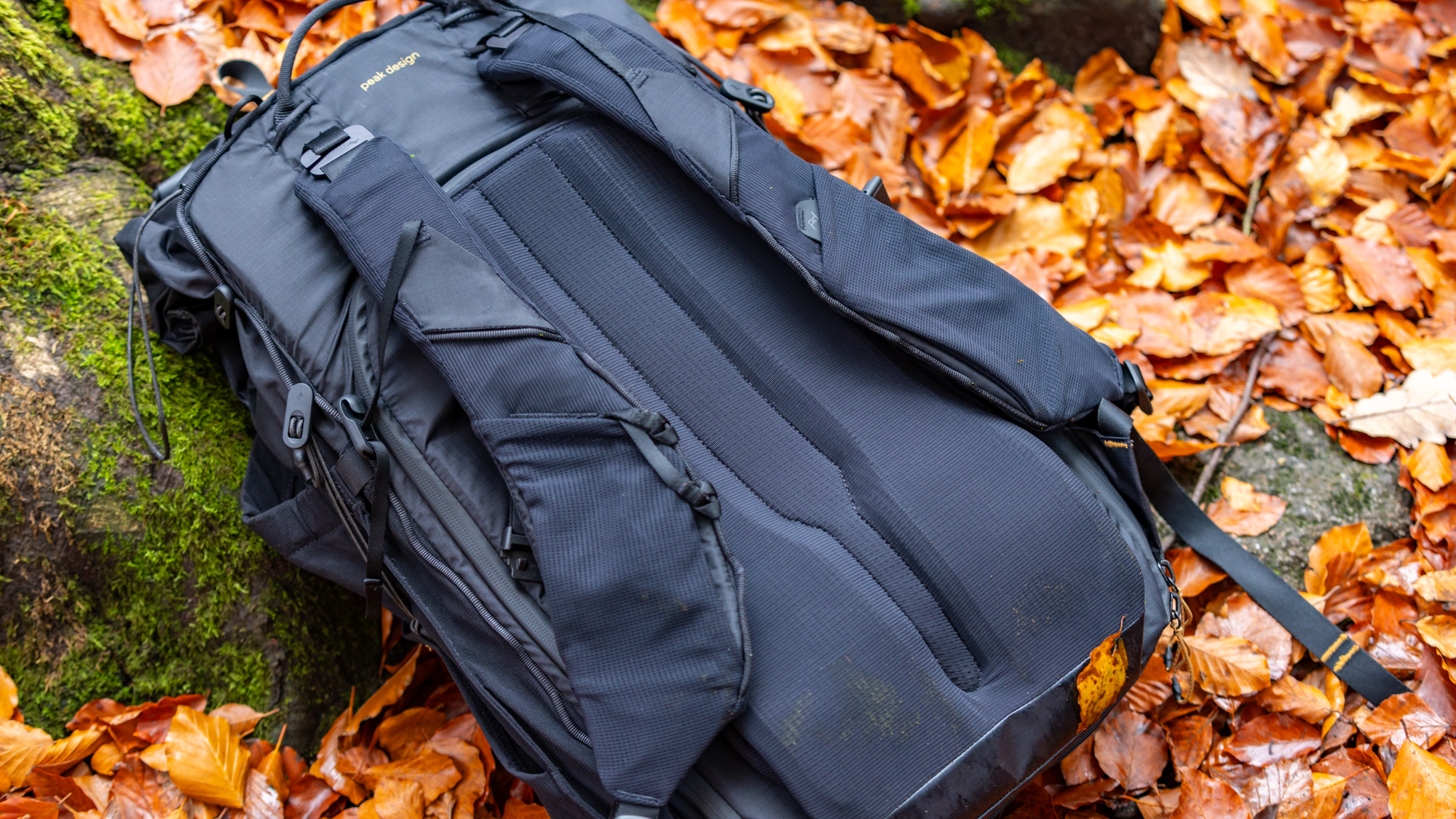
It’s worth noting that while the rolltop can be unrolled to expand the internal storage space (3L of expansion on the 25L and 10L expansion on the 45L), as you unravel it the bag becomes a little less watertight.
Whilst perfectly fine in a light shower you will want to use the Peak Design Rain Fly if you are caught out in a heavy downpour. It's sold separately, though is included in some bundles. We’d also recommend fully zipping up any internal Camera Cubes you have fitted during inclement weather for an extra barrier of protection for your camera kit.
Speaking of the Camera Cubes and Packing Cubes they are fully modular and can be removed or configured in a wide variety of ways to suit your shooting. While the Camera Cubes are generally best used facing out toward the large rear door hatch, the Packing Cubes designed for clothes, food, or other non-camera items, can be set up to face the rear door or pointing upwards for quick access via the rolltop opening.
One issue I have with the Camera Cubes is that they're not the deepest. You might be tricked into thinking these bags are extremely roomy inside, but they are a bit hampered by the rather poultry depth of just 13.5cm – this is the same on all of the Camera Cube 2 series regardless of size.
On my photography trip to the Peak District, I was joined by another photographer who was using the f-stop Tilopa 50L DuraDiamond which takes an ICU Pro Large. I was quite envious of his roomy internal compartment which had a much deeper 16.5cm insert and happily would take a big filter case for square 100mm NDs and soft or hard graduated filters.
With my stingy storage space though I resorted to stashing my filters outside of the Camera Cube in the rolltop section of the backpack which made it a bit of a faff to get to. This was particularly frustrating on the larger 45L version as access to the top section of the backpack through the rear access hatch with the largest cube inserted was hampered by the metal frame, so you have to open the rear hatch door to get to your camera kit, then close that up and re-enter the bag through the roll-top to get to the filters and then close that all up. Admittedly, this was a problem with my specific setup, and it wouldn't be so much of an issue if you traveled lighter and used smaller screw-in filters, which I think works better for these bags given the constraints of its depth.
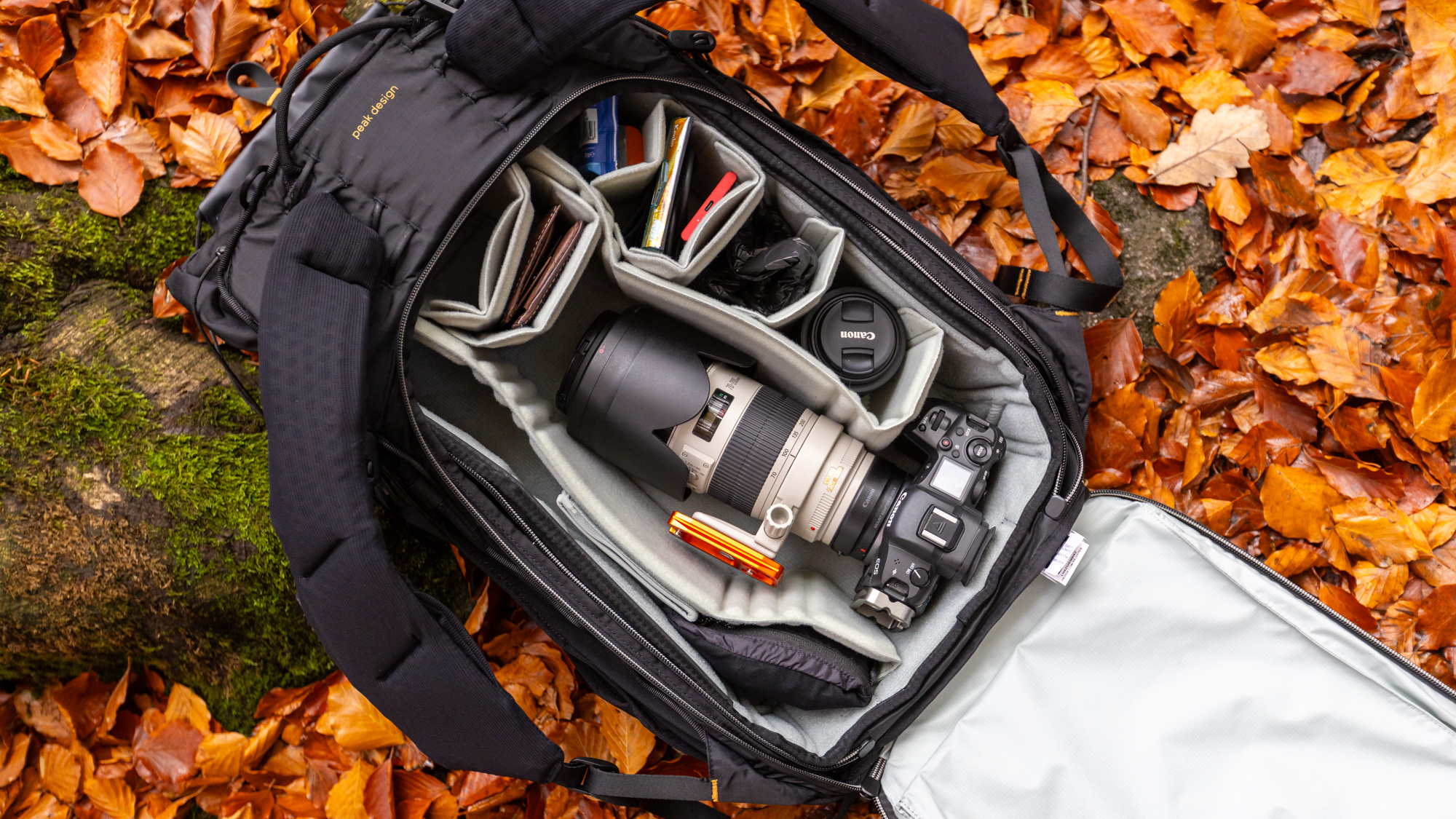
The Outdoor 25L and 45L bags are a strong attempt at crossing the line between conventional outdoor hiking backpacks with camera bags and do this with their modular design which you can customize to your heart's content using the Camera Cubes V2 and Packing Cubes in a combination that works for your specific needs or even based around a specific trip.
The new Outdoor Backpacks don’t feature a suspension system as some dedicated hiking backpacks do. However, they have plenty of ways to adjust to your size, plus comfortable shoulder straps, dual sternum straps, and a fold-away Hip Belt on the 45L, (available for the 25L at extra cost).
Beefy padding all the way around the top of the shoulder straps might seem overkill but this was a welcome addition and improves comfort around where the shoulder straps might rub against your neck.
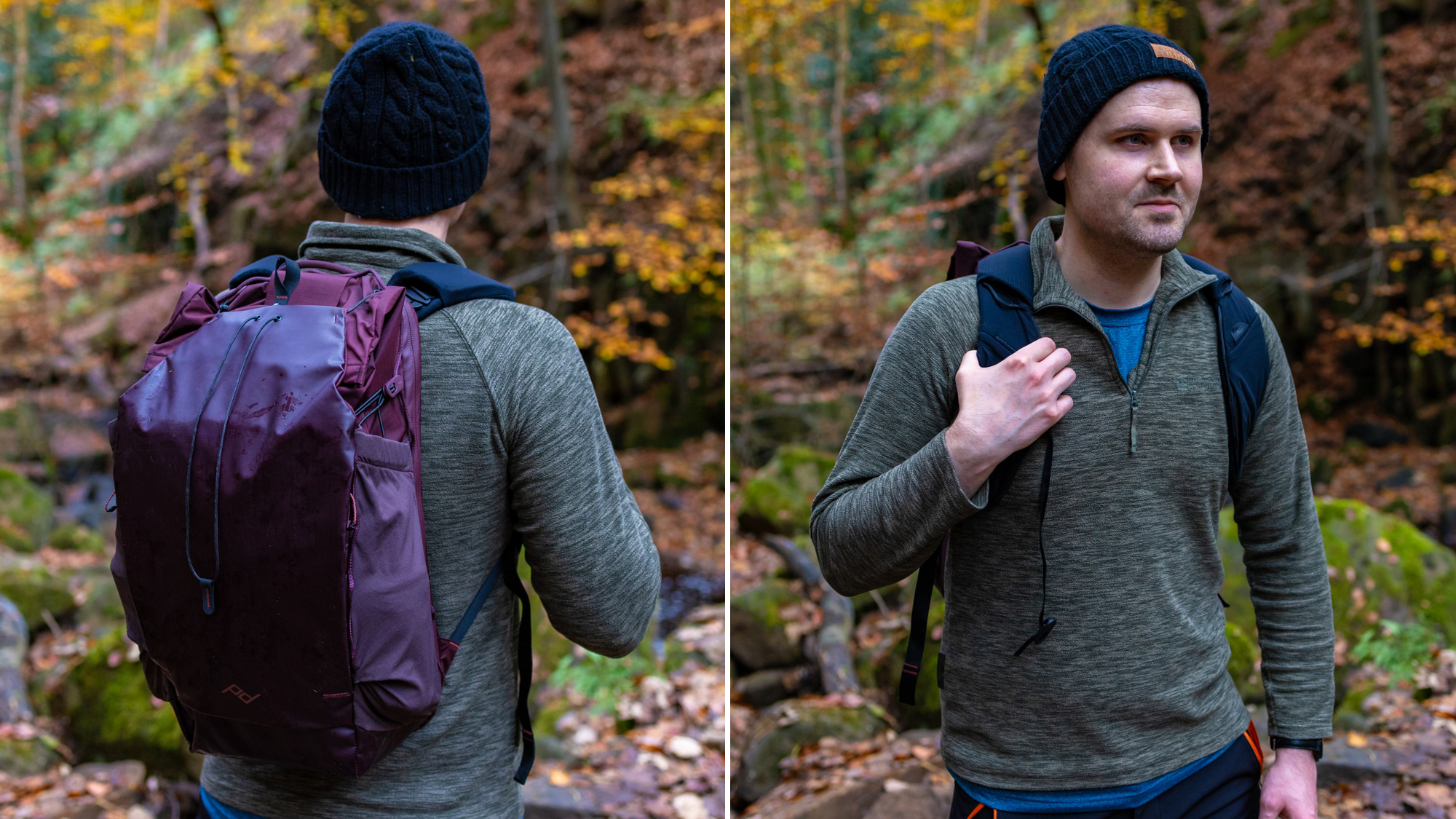
As a Peak Design bag, it’s perhaps unsurprisingly been made to work optimally with proprietary Peak Design accessories. It features several mounting points on the shoulder and waist straps to fit a Peak Design Capture Clip to hang your camera from or stash the low-profile Peak Design Travel Tripod in one of the stretchy side pockets. It’s also been set to work well with the new Peak Design Outdoor 2L or 7L Sling bags which can be connected across the front or rear of the backpacks.
There are hidden cord rails strategically sewn around the edges of the bag which give you plenty of mounting points to tie cords to, for either compressing the bag to give it a tight and compact form or for securing big awkward items like walking poles when mounted in the stretchy side pockets.
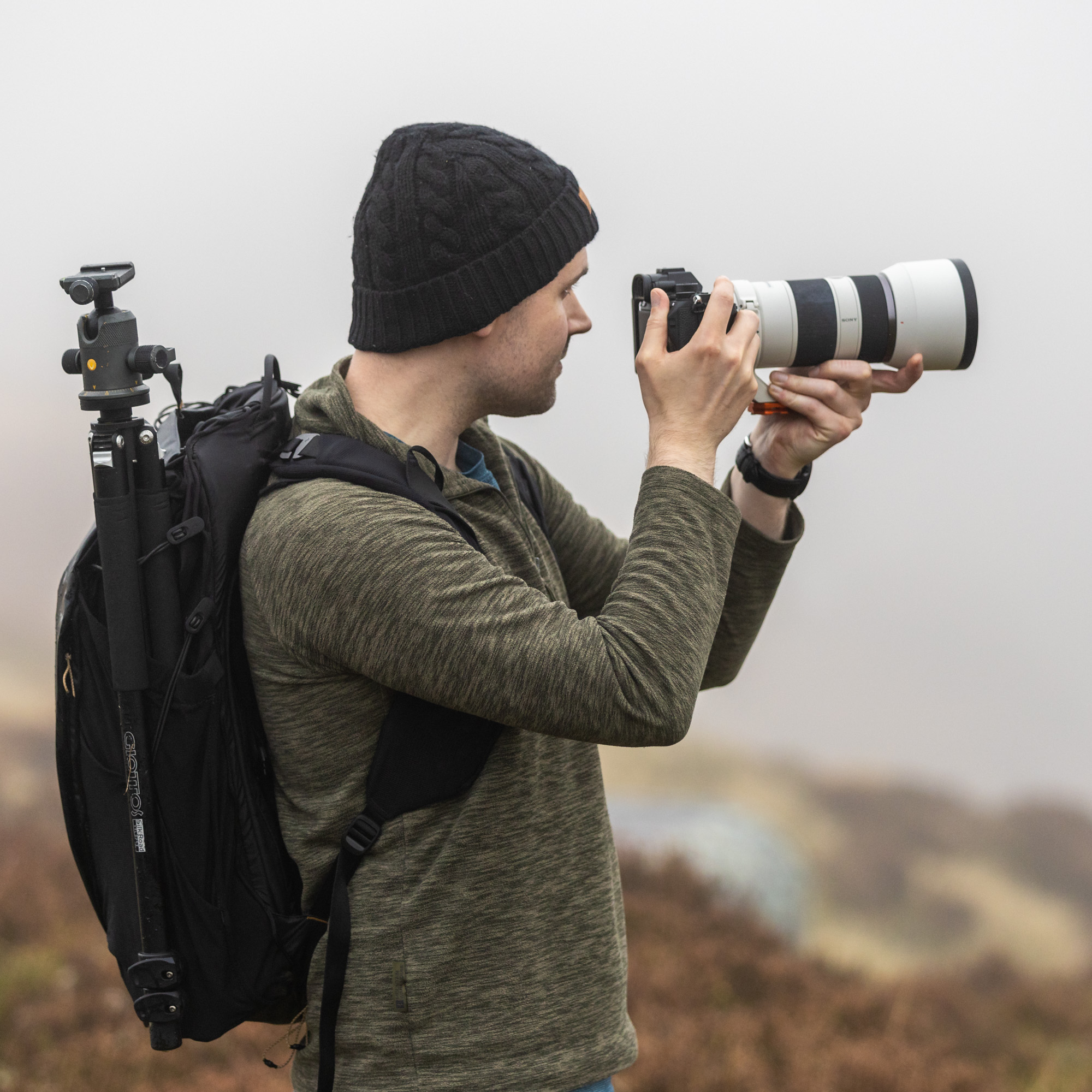
Whilst out hiking in the Peak District with the Outdoor Backpacks my photographer friend had the f-stop Tilopa 50L DuraDiamond – a similar modular hiking backpack made for the outdoors. It became evident that the Peak Design Outdoor Backpacks are predominantly made for hikers first and photographers second, whereas, on the f-stop bag, it was the other way around.
This was evident from the f-stop bag having loads of little pockets built into its internal laptop storage pocket, great for stashing accessories such as memory cards, cables, hard drives, batteries, and all the sorts of awkward small items we photographers carry on a shoot. With the Peak Design Outdoor Backpacks, it's sorely missing the smaller pockets so accessories have to be stashed inside of the Camera Cube V2 and you'll need a battery organizer and memory card case to have any hope of keeping these somewhat organized.
The Outdoor Backpacks do however cater more for the outdoor adventurers who need the bag mainly for hiking, trekking, and camping – with all of the various straps and lashing points across them, and if you fancy doing a little photography on your trip you can use one of the inserts, or completely leave the camera kit at home and fit in big items like a tent or sleeping bag on the 45L model.
Verdict
The Peak Design Outdoor Backpacks live up to their name and they're well-suited to hiking, trekking, and camping when you're out in the wild. While both 25L and 45L options come packed with useful features, I get a strong impression that the priority of these bags is for outdoor hiking and trekking, with the photography aspect coming second. This is really seen from the shallow depth of the Camera Cubes and no little storage pockets anywhere on the bags to help you organize camera cables, memory cards, hard drives, cleaning cloths, or other accessories, so the Camera Cube V2's can end up looking messy and poorly organized.
This is not to say the Outdoor Adventure backpacks aren't brilliant bags – they are, and their build quality and materials are nothing short of impressive. But from my testing, I would recommend them to somebody who loves the outdoors and exploring, with a little bit of photography, rather than the other way around.
If your balance is the other way around, with photography the priority first and foremost and hiking coming second then the f-stop Tilopa 50L DuraDiamond will likely have a better balance for you. Both are brilliant large $350-ish bags, but one pivots towards hiking, while the other toward camera kit.
So if you're looking for an outdoor photography backpack that prioritizes hiking, trekking, and camping features then the Peak Design 25L and 45L Outdoor Backpacks will be the choice for you! They're super comfortable to trek with on long journeys and have heaps of customization to make sure you get the perfect fit for your body. Plus, they're made from premium and sustainable materials, in particular, I really loved the Weatherproof Terra Shell front which is rugged and also easy to clean. The Hip Belt and metal frame of the larger 45L model also made it really comfortable to wear whilst hiking.
| Features | Outdoor Backpacks feature Ultra Cinch, Ultra Zips, and Cordhook with weather-resistant materials for photographers. | ★★★★★ |
| Design | The Outdoors Backpacks feature premium materials, comfortable design, and modular customization for photographers and hikers, ensuring safety and versatility. | ★★★★★ |
| Performance | The bags are durable and weather-resistant, but lack internal pockets for accessories, requiring external management pouches for organization. | ★★★★☆ |
| Value | Peak Design Outdoors Backpacks cost $250-$330, plus extra for Camera and Packing Cubes, making them pricier than similar options. | ★★★★☆ |
Should you buy the Peak Design Outdoor Backpack 25L and 45L?
✅ Buy this if...
- You need an outdoor backpack for both hiking adventures and photography walks
- You need an outdoor backpack with the latest innovative features
🚫 Don't buy this if...
- You don’t want to buy into an expensive modular system
- You're on a tight budget
Alternatives
If you’re an avid camper and your main camera rucksack has a GearUp insert, the LowePro RunAbout is a no-brainer. It’s a well-designed folding daypack that’s easy to stow and should appeal to photographers and dedicated hikers alike.

Deputy Editor on PhotoPlus: The Canon Magazine, Dan also brings his technical wizardry and editing skills to Digital Camera World. He has been writing about all aspects of photography for over 10 years, having previously served as technical writer and technical editor for Practical Photography magazine, as well as Photoshop editor on Digital Photo.
Dan is an Adobe-certified Photoshop guru, making him officially a beast at post-processing – so he’s the perfect person to share tips and tricks both in-camera and in post. Able to shoot all genres, Dan provides news, techniques and tutorials on everything from portraits and landscapes to macro and wildlife, helping photographers get the most out of their cameras, lenses, filters, lighting, tripods, and, of course, editing software.
